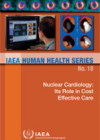According to the WHO, cardiovascular diseases are the most common cause of death worldwide. Diagnostic procedures using ionizing radiation play a central role in managing these diseases and have significantly contributed to the decrease in morbidity and mortality associated with them in the last two decades.
Cardiovascular diseases
Almost all diagnostic imaging methods for cardiovascular diseases require radiation. They can be divided into invasive and non-invasive methods.
With invasive techniques, a catheter – a long, thin, flexible tube – is inserted into a peripheral artery and threaded to the heart. Through this catheter, a contrast media is injected into the blood stream, following which X-rays are used to take pictures of the heart’s anatomy and the arteries that bring blood to the heart muscle to assess the degree of their openness, also called patency.
This procedure, called cardiac catheterization, is the "gold standard" to evaluate the cardiac anatomy and the severity of a physiological dysfunction. It is recommended for various reasons, the most common of which is to evaluate chest pain. However, its wide usage is limited by its invasive nature.
Instead, non-invasive cardiac imaging techniques are increasingly used. These methods can delineate cardiac structures and assess coronary arteries patency and myocardial perfusion (showing how well blood flows through heart muscles) as well as their function and metabolism. Some of them use radiation and coronary computed tomography angiography, a heart imaging test that helps determine if plaque build-up has narrowed a patient's coronary arteries. Others use non-nuclear methods, such as echocardiography, a sonogram of the heart using ultrasound, or cardiac magnetic resonance imaging, a technology that employs pulses of radio wave energy.
Key methods of nuclear medicine
Nuclear cardiology studies assess the circulation of blood in the blood vessels of the heart muscle, also known as myocardial blood flow. Among the techniques of nuclear cardiology, myocardial perfusion imaging is the most widely used. Combined with exercise on a treadmill or stationary bicycle, the images produced with this method can be used to assess the blood flow to the heart muscle.
To produce these images, a small amount of a chemical (a so-called imaging agent) is injected into the blood stream. Then, a scanning device (for instance a gamma camera) is used to measure the uptake by the heart of the imaging material. If there is significant blockage of a coronary artery, the heart muscle may not receive enough blood supply. This decrease in blood flow can be detected on the images.
Myocardial perfusion studies can identify areas of the heart muscle that have inadequate blood supply and those regions that might be scarred from a heart attack. This provides the necessary information to help identify which patients carry an increased heart attack risk and may be candidates for invasive procedures such as coronary angiography, angioplasty (a procedure to widen narrowed or obstructed arteries) or heart surgery.








